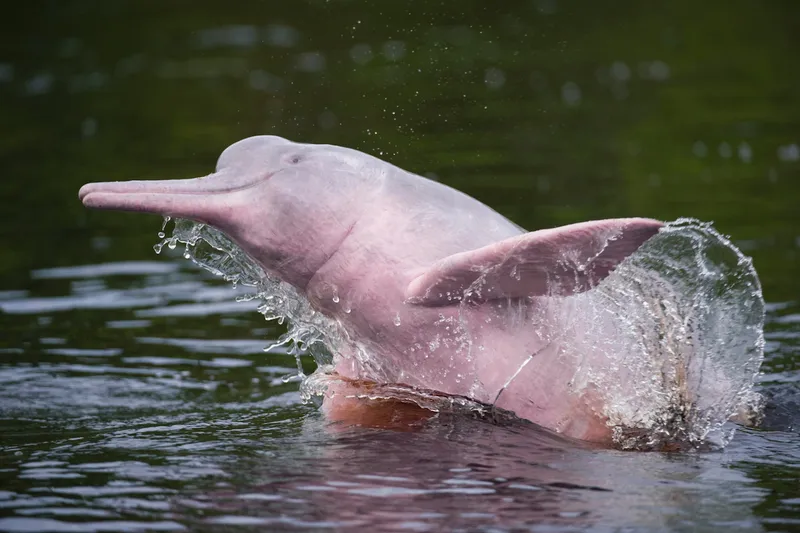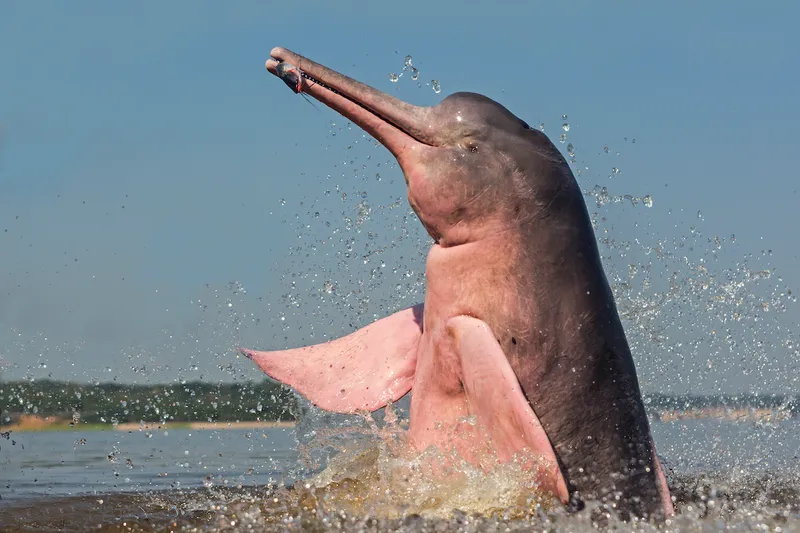Hold onto your swim caps, we're about to dive into the world of the Amazon river dolphin, aka the pink river dolphin (Inia geoffrensis) - the most fabulous and flamboyant member of the dolphin family. Found only in the murky waters of South America's Amazon River basin, these barbie-pink creatures are a fantastic sight, but as with much that is out of the ordinary, they’re also shrouded in mystery and folklore.
With their rosy hues and playful personalities, Amazon river dolphins are the very definition of ‘extra’. But, why are they pink in the first place? How fast can they swim? And what’s being done to save them from extinction?
- Discover some of the weirdest animals on the planet
Why is the amazon river dolphin pink?
It’s the first thing you notice, and the reason for their nickname; and it’s this unique pinkish colouration that sets the Amazon river dolphin apart from other dolphin species. The exact reason is still not fully understood, but it is believed to be due to a combination of genetics, diet, and environmental factors.
One reason for the pink colouration is a result of their diet, which is high in carotenoids – an organic pigment found in the fish and crustaceans they eat. Carotenoids are known to contribute to the pink or orange colour of some birds (like flamingoes), fish, and reptiles, so it’s likely that the same mechanism is responsible for the pink in the dolphins. Carotenoids are the most widely distributed pigments in nature and are also present in some species of fungi.
“This freshwater cetacean is the largest species of river dolphin. They are born grey and acquire their pink colour with age. Their final hue is influenced by many things, including behaviour, diet and how close their capillaries are to the skin,” explains biologist and author Helen Pilcher.
In addition, a combination of genetics and environmental factors likely plays a part. Some studies have suggested that the pink colouration may be related to skin thickness, which can affect how much blood shows through the skin. It is also possible that hormones, stress, or other factors may play a role in the colour of the pink river dolphin.
What does an Amazon river dolphin look like?
Aside from their distinctive pink hue, Amazon river dolphins have a robust body with a fusiform shape (a tapered spindle shape) and a long snout (the technical term for which is a ‘rostrum’) filled with two types of teeth. They have sharp, pointy teeth at the front for catching prey, and – like humans – flatter teeth at the back for grinding.
They have a prominent, bulging forehead, known as a ‘melon’. Yes, the dolphin’s distinctive forehead is called a melon, and it houses the dolphin's echolocation system. The pink river dolphin can even change the shape of their melon, which researchers believe could help them change the echolocation's pulse direction, size and/or frequency.

Like most dolphins, their sleek and streamlined body is designed for slipping through the water – and jumping above the surface – which in this case, is the murky depths of the Amazon River. Their long and powerful tail is used for propulsion and steering. Likewise, their eyes are relatively small and are generally thought to have poor eyesight, but in low light conditions, the pupils are adapted to dilate, allowing them to see more clearly in the dimly lit Amazonian waters.
But unlike other dolphins, the spine of the Amazon river dolphin is not fused together, meaning they can turn their head side-to-side. Handy for making tight turns.
Their wide, paddle-shaped flippers can move independently of one another, and are well-suited for manoeuvring through the river's complex currents and obstacles, or for chasing a tasty meal into a flooded forest area. However, they are not designed for super-fast speeds, especially when compared to their faster ocean-dwelling cousins.
Where does the pink river dolphin live?
While dolphins are most commonly associated with saltwater oceans, there are five species that have adapted to the freshwater of several major rivers:
- The tucuxi
- Ganges River dolphin
- Indus River dolphin
- Irrawaddy dolphin
- Amazon River dolphin
The pink river dolphin, or Amazon river dolphin – also known as a boto – is found throughout the Amazon and Orinoco river basins of South America, spanning Brazil, Peru, Venezuela, Bolivia, Ecuador and Guyana.
How much does a pink river dolphin weigh?
The Amazon pink river dolphin is the largest freshwater dolphin in the world.
Adult males can reach lengths of up to 2.7 metres (9 feet) long and weigh up to 180kg (400 lbs).
Adult females are typically slightly smaller, weighing around 100kg (220 lbs) on average.
How fast can a pink river dolphin swim?
The pink river dolphin is a relatively slow-swimming species compared to its ocean-dwelling counterparts. Adult pink river dolphins typically swim at speeds between 8-13 km/h (5-8 mph), with occasional bursts of up to 24 km/h (15 mph) over short distances (perhaps in pursuit of a tasty snack).
But despite their slower speed, pink river dolphins are highly manoeuvrable. They have to be, as the Amazon River can throw up complex currents, and various obstacles that need dodging at the last minute.
Their short, paddle-like flippers and long, powerful tail make them well-suited for navigating through shallow and narrow waterways, allowing them to catch fish and avoid predators in the Amazonian waters.
What does the pink river dolphin eat?
Pink river dolphins have a flexible and varied diet – perhaps thanks in part to their two types of teeth – and the specific types of prey may vary depending on factors such as location, season, and availability of food.
The pink river dolphin feeds primarily on a wide variety of fish found in the Amazon River and its various tributaries. Some of the fish species that are commonly consumed by pink river dolphins include piranhas (yikes!), catfish, characins, and tetras.

In addition to around 50 species of fish, pink river dolphins may also eat crustaceans, such as crabs and shrimp, as well as small turtles and freshwater molluscs. They use echolocation to locate their prey (remember the melon?), emitting high-pitched clicks and listening for the echoes that bounce back through the often-murky water. These echoes are received by the dolphin’s lower jawbone.
Why are river dolphins endangered?
Pink river dolphins were granted internationally protected status back in 2018 and are listed as a vulnerable species by the International Union for Conservation of Nature (IUCN).
Habitat degradation, from activities such as deforestation, mining, dam construction and flow alteration, has disrupted the dolphin's ecosystem and reduced its available food source. Pollution from agricultural runoff and industrial waste have further compromised water quality of the Amazon river, while accidental entanglement in fishing gear and direct hunting for bait, meat, or traditional medicines pose a serious risk to the species.
As a slow-reproducing and long-lived mammal, the pink river dolphin is particularly vulnerable to these threats, and there is an urgent need for conservation efforts to safeguard its survival.
There are also specific, significant threats to their survival, including mercury pollution from (often illegal) gold mining activities. Even though such activities can be small-scale, they’re cited by the WWF as one of the main threats to the Amazon river dolphin (and subspecies); mercury deposits enter the water, catfish ingest the mercury, and the dolphins eat the catfish.
What is being done to save the Amazon river dolphin?
Despite the rather grim outlook, efforts are being made to save the Amazon pink river dolphin. Some of the actions being taken include:
Habitat conservation
Efforts are being made to protect the natural habitat of the pink river dolphin and restore damaged or degraded ecosystems. This includes initiatives such as reforestation, riverbank restoration, and reducing pollution levels.
Education and awareness
Campaigns are being conducted to educate local communities about the importance of preserving the pink river dolphin and its habitat. This includes programs that engage local people in conservation activities, such as monitoring dolphin populations and reducing the use of fishing gear that may harm dolphins.
Law enforcement
Governments are enforcing laws to prevent hunting, accidental catching, and other illegal activities that harm the pink river dolphin.
Research and monitoring
Scientists are studying the biology, behaviour, and population dynamics of the Amazon pink river dolphin to gain a better understanding of their needs and vulnerabilities. And technology is helping - there has been success using drones known as unmanned aerial vehicles (UAVs) over 80km (50 miles) of the Juruá River in Brazil, which provided a higher level of accuracy than human observers. This information is used to guide conservation efforts and policy decisions.
Read more: